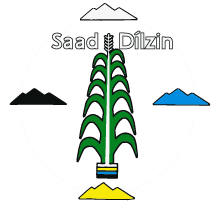Introduction to Navajo Questions
Any competent speaker of any language will be able to form questions. This resource is a combined grammar and lexicon of Navajo questions. We provide a description of three kinds of questions along with glossed examples and audio recordings of them. We think this resource will be useful to students and teachers of this language, and to professional linguists within and outside Navajo communities.
We distinguish three distinct kinds of questions: Yes/no questions, Content Questions, and Alternative Questions. We treat Tag Questions as a subtype of Yes/no questions. For this project we draw on previous work by Fernald & Perkins (manuscript), Young & Morgan (1987), Young, Morgan & Midgette (1992), and others cited in References [link].
| Da’ | Na’nízhoozhígóó | díníyá? |
| Q | Gallup-to | 2-go.F |
| Are you going to Gallup? | ||
| Mary | ha’át’íí | nayiisnii’? |
| Mary | what | 3-3-buy.P |
| What did Mary buy? | ||
| ’Atsį́’ísh | ’éí | doodaii’ | łóó’ísh | nínízin? |
| meat-Q | TOP | or | fish-Q | 3-2-want.NI |
| Do you want meat or fish? | ||||
Example (1) is a yes/no question, which has ‛yes’ or ‛no’ as an answer. Questions like this are used to ask whether a particular statement is true or not. In this example, the statement being asked about is Na’nízhoozhígóó díníyá, which means ‛You are going to Gallup’.
Content questions, like example (2), do not have simply ‛yes’ or ‛no’ as an answer. Rather than supplying a statement and asking whether it is true or not, they have the effect of providing a statement with some missing information, and they ask what that information is. In (2), the idea is that Mary bought something, and the question asks what that something is.
Alternative questions present the addressee with a choice between two or more options. Note that the English gloss in example (3) can be understood as either a yes/no question (if the intonation is rising on fish) or an alternative question (if the intonation is falling on fish). In Navajo, the sentence is an alternative question for which the appropriate answer will indicate which one of the choices is desired.
Glossing conventions and a note on morphology are here [link].
Ła’ ha’nitáhígíí ’éí biihidzóhí 50 entries
ʼAghááł chidí bídadooltłʼółígíí k'ad hashtʼe dadiilnííł.
rattle rope car 3-3-tie-ÍGÍÍ.F now 3-prepare 3-1pl-make.F’Awéé’ dah biséłdá.
baby up 3-1-CAUS-hold.AnO.SPN’Áhéhee’ dóó baa ’ahééh nisin.
thank.you and 3-for appreciation 1-think.CI’áko shį́į́ ’índa
CONJ’Áłah ’aleehgo ch’iyáán ’ádadiilnííł ’áko shį́į́ ’índa diné ndahidookah.
meeting-Comp food 3-1-Pl-make.F CONJ people 3-Pl.will-arrive.FBeehaz’áanii biaad késhdę́ę́’į́">k’ehgo baa hwiiníst’įįd.
laws 3-according-to-GO 3-about 3-discuss.Pbik’ídadiidis
pl-3DO-1dpl-wrap.it.around.it.Ibik’ídadohdis
pl-3DO-2dpl-wrap.it.around.it.Ibik’ídideesdis
3DO-1-wrap.it.around.it.FChidí t’ą́ą́’ nináníłbą́ą́z.
car just 3-1-reparked.RDa’ ’áájí ’ałdó’ ’áłah ’azlį́į́’?
Q that-side also meeting 1-happen.PDa’ naadą́’ísh nee hólǫ́?
Q corn-Q 2-with 3-exist.NIdadidíníilkał
pl-3DO-1dpl-start.to.herd.them.(animals).Fdah
Dibé bighan báátis dah yiishte’.
sheep corral 3-over up 1-climb.PDibé tóógóó dínóshkaad.
sheep water-toward 3-1-start.herd.Odidínéeshkał
3DO-1-start.to.herd.them.(animals).Fdidííníłjéé’
3DO-2-start.fire.PDíigi ’át’éego yigááł.
this-similar.to 3-walk.ProgDíí tł’éé’ t’áá ká dóola dá’ák’eólyeed lágo, dádiʼnítįįh.
this night NEG bull into.field-3-run.O hope.not 3-2-close.gate.Ibee ’ééhóziní
- Command, negativefind in Navajo Imperatives
- Optative with t’áá ká and lágofind in Navajo Imperatives
- t’áá ká don’tfind in Navajo Adverb Lexicon
- lágo negative particle used with the optative modefind in Navajo Adverb Lexicon
- Optative (O)find in Navajo Verb Modes
- Command, affirmativefind in Navajo Imperatives
- T’ahdii baa na’aldeehfind in Navajo Imperatives
- Imperfective (I) (∅, ni, si, yi-∅)find in Navajo Verb Modes
Díidí háísh bichidí?
this who-Q 3-cardííłbish
3DO-2-boil.it.FGohwééh t’áá bizhání ’éí doodaii’ ’abe’ biłgo daats’í nínízin?
coffee only TOP or milk perhaps 3-with 3-2-want.NIHa’a’aahdę́ę́sh naaghan ’éí doodago e’e’aahdę́ę́sh naaghan?
east-from-Q 2-home TOP or west-from-Q 2 homeHa’át’éegoshą’ ’ayóo náníldzid?
why-Q very 2-fear.Ihadajishgizh
pl-3DO-4dpl-cut.it.out.PHastiin dóó ’at’ééd ha’át’íí lá ’áyiilaa?
man and girl what Q 3-3-make.PHáidíígíísh łį́į́ʼ bił deeshdlóózh?
which.one-ÍGÍÍ-Q horse 3-with 3-crawl.FK’ad hooghangóó nááshdááł dooleeł.
now hogan-toward 1-go.Prog FUTKintahdę́ę́’ hahí néínídzáá lá.
town-from quickly 2-return.P DISCNaalyéhé bá hooghandi tł’oh hániikai ńt’éé’ ’áníídí yee’ ’ásdįįd lágo ’áadi niikai.
trading.post-at hay 1dpl-go.pl.P past recently very 3-disappear.P DISC-GO there 1dpl-go.pl.Pbee ’ééhóziní
- -á for, for the benefit offind in Navajo Postposition Lexicon
- benefactive
- -di atfind in Navajo Postposition Lexicon
- location
- ńt’éé’ relates to past timefind in Navajo Adverb Lexicon
- time
- ’ániidígo recently, not long agofind in Navajo Adverb Lexicon
- time
- -go verb and subordinating encliticfind in Navajo Adverb Lexicon




